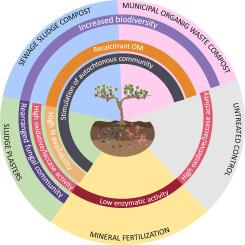Waste-derived organic soil amendments for a sustainable vineyard management: Linking microbiome responses to soil biochemistry
IF 5
2区 农林科学
Q1 SOIL SCIENCE
引用次数: 0
Abstract
Products obtained from various organic wastes recycling processes can represent sustainable alternatives to traditional fertilizers in vineyard management. In this study, three waste-derived organic-based amendments were applied consistently for the first three years from plantation in an experimental vineyard in Northern Italy. The amendments included municipal organic waste compost, sewage sludge compost, and ‘plasters’ derived from the alkaline hydrolysis and pH neutralization of sludges. Aim was exploring the effects of these amendments on soil biochemistry, including physicochemical properties and main enzymatic activities, together with soil microbiome variations. Microbial community composition was analyzed by bacterial 16S and fungal ITS regions sequencing and network analysis, also studying its correlations to changes in soil C and N pools. The matrices did not act as microbial inocula. Instead, they stimulated specific autochthonous microbial populations and had a deep and varied impact on the cumulative fungal and bacterial network of interactions. Compost-based amendments representing a source of recalcitrant carbon, significantly promoted soil biodiversity and increased microbial biomass. Sludge plasters, a more easily degradable C and N source, promoted the proliferation of copiotrophic bacteria and unexpectedly resulted in a deep rearrangement of the fungal population, leading to increased laccase activity. Although the organic matrices were applied considering their different susceptibility to release available N over time, by applying different mineralization coefficients, significant differences were found in the accumulation of soluble forms of N and C in soil, with the consequent differences in microbial compositional and functional responses. These findings suggest the need for in-depth studies to formulate specific guidelines for the use of compost-based matrices, and especially sludge plasters, in the field. Compost-based matrices behaved like soil amendments, while sludge plasters behaved like mineral fertilizers. Together they could be used to maintain soil fertility and meet plant nutritional needs.

废物来源的有机土壤改改剂用于可持续葡萄园管理:将微生物组反应与土壤生物化学联系起来
从各种有机废物回收过程中获得的产品可以代表葡萄园管理中传统肥料的可持续替代品。在这项研究中,在意大利北部的一个实验葡萄园中,从种植开始的前三年,一直使用三种废物衍生的有机基改进剂。修正案包括城市有机废物堆肥、污水污泥堆肥和由污泥的碱性水解和pH中和产生的“石膏”。目的是探讨这些改良剂对土壤生物化学的影响,包括理化性质和主要酶活性,以及土壤微生物组的变化。通过细菌16S和真菌ITS区测序和网络分析分析微生物群落组成,并研究其与土壤C、N库变化的相关性。基质不具有微生物接种作用。相反,它们刺激了特定的本地微生物种群,并对累积的真菌和细菌相互作用网络产生了深刻而多样的影响。以堆肥为基础的改良剂代表了顽固性碳的来源,显著促进了土壤生物多样性和微生物生物量的增加。污泥膏药是一种更容易降解的C和N源,它促进了共生细菌的增殖,出乎意料地导致真菌种群的深度重排,导致漆酶活性增加。尽管施用有机基质时考虑了它们对有效氮随时间的不同释放敏感性,但通过施用不同的矿化系数,发现土壤中可溶态氮和碳的积累存在显著差异,从而导致微生物组成和功能响应的差异。这些发现表明,需要进行深入的研究,以制定具体的指导方针,以便在现场使用堆肥基质,特别是污泥膏药。基于堆肥的基质表现为土壤改良剂,而污泥石膏表现为矿物肥料。它们一起可以用来保持土壤肥力和满足植物的营养需求。
本文章由计算机程序翻译,如有差异,请以英文原文为准。
求助全文
约1分钟内获得全文
求助全文
来源期刊

Applied Soil Ecology
农林科学-土壤科学
CiteScore
9.70
自引率
4.20%
发文量
363
审稿时长
5.3 months
期刊介绍:
Applied Soil Ecology addresses the role of soil organisms and their interactions in relation to: sustainability and productivity, nutrient cycling and other soil processes, the maintenance of soil functions, the impact of human activities on soil ecosystems and bio(techno)logical control of soil-inhabiting pests, diseases and weeds.
 求助内容:
求助内容: 应助结果提醒方式:
应助结果提醒方式:


